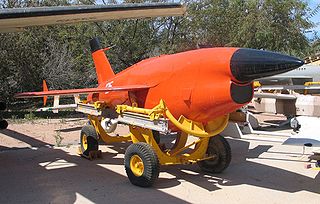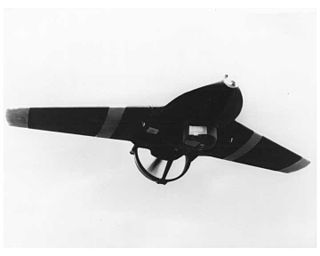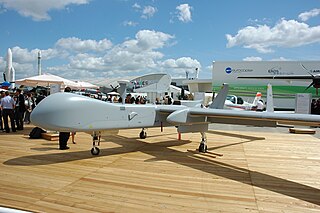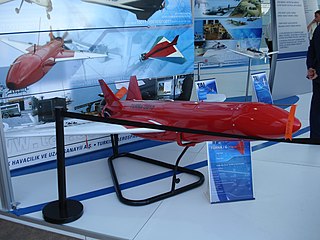
The Lockheed DC-130 was a variant of the C-130 Hercules, designed for drone control. It could carry four Ryan Firebee drones underneath its wings.

The Boeing Insitu ScanEagle is a small, long-endurance, low-altitude unmanned aerial vehicle (UAV) built by Insitu, a subsidiary of Boeing, and is used for reconnaissance. The ScanEagle was designed by Insitu based on the Insitu SeaScan, a commercial UAV that was intended for fish-spotting. The ScanEagle continues to receive improvements through upgrades and changes.

The Ryan Model 147 Lightning Bug is a jet-powered drone, or unmanned aerial vehicle, produced and developed by Ryan Aeronautical from the earlier Ryan Firebee target drone series.

The Ryan Firebee is a series of target drones developed by the Ryan Aeronautical Company beginning in 1951. It was one of the first jet-propelled drones, and remains one of the most widely used target drones ever built.

The Ryan AQM-91 Firefly was a developmental drone developed during the Vietnam War to perform long-range reconnaissance, especially into China.

The Qods Mohajer is an Iranian single-engine tactical unmanned aerial vehicle (UAV) built by the Qods Aviation Industry Company in four main variants from the 1980s to the present day. The Mohajer family is primarily used for reconnaissance, and is among the most mature and well-known Iranian UAVs.

The BAE Systems Phoenix was an all-weather, day or night, real-time surveillance Unmanned Air Vehicle. It had a twin-boom UAV with a surveillance pod, from which the imagery was data linked to a ground control station (GCS) that also controlled the aircraft in flight. It was the third generation of UAV in British Army service with the Royal Artillery after SD/1 and Canadair Midge.

Lakshya is an Indian remotely piloted high speed target drone system developed by the Aeronautical Development Establishment (ADE) of DRDO. A variant Lakshya-1 is used to perform discreet aerial reconnaissance of battlefield and target acquisition.

The Lockheed MQM-105 Aquila (Eagle) was the first small battlefield drone developed in the United States during the 1970s to act as a target designator for the US Army.

The Sagem Crecerelle ("Kestrel") is a reconnaissance UAV developed in France in the 1990s, based on the Meggitt Banshee target drone. Its configuration is much like that of the Banshee, with a pusher prop, a clipped delta wing, and a single tailfin, though its fuselage is more cylindrical. It is powered by a 20 kW (26 hp) rotary engine and has no landing gear, being recovered by parachute and airbags. The Crecerelle saw action with French forces during the Kosovo campaign in 1999. Meggitt sells much the same machine as the Spectre.

The EADS Harfang, formerly known as Système intérimaire de drone MALE is a drone system used by the French Air Force, supplementing the RQ-5 Hunter.

The MQM-42 was a supersonic target drone developed by North American Aviation. Developed in two subvariants, Redhead and Roadrunner, it was used by the United States Army in the 1960s and 1970s.

The HESA Karrar is an Iranian jet-powered target drone manufactured by Iran Aircraft Manufacturing Industrial Company (HESA) since 2010. The Karrar is a derivative of the American 1970s-era Beechcraft MQM-107 Streaker target drone, probably incorporating elements from the South African Skua, with hardpoints added for munitions. The Karrar was developed during the Ahmadinejad presidency.

TAI Turna is a turboprop-powered radio-controlled target drone introduced in 2001. Designed, developed and built by Turkish Aerospace Industries (TAI) and powered by an engine manufactured by Tusaş Engine Industries (TEI), the unmanned aerial vehicle (UAV) is in use by the Turkish Armed Forces in target tracking and gunnery firing exercises.
TAI Pelikan, aka IHA-X2, is a radio-controlled reconnaissance, surveillance and target acquisition drone. Designed, developed and built by Turkish Aerospace Industries (TAI), the unmanned aerial vehicle (UAV) is a half scale model of the tactical drone TAI Baykuş air platform. It was produced as a training and bridge platform to the TAI Baykuş.

TAI Gözcü is a radio-controlled short-range tactical drone. Designed, developed and built by Turkish Aerospace Industries (TAI), the unmanned aerial vehicle (UAV) is in use by the Turkish Armed Forces for intelligence, surveillance, target acquisition and reconnaissance purposes. Gözcü is the Turkish word for observer.
TAI Baykuş is a radio-controlled tactical unmanned drone designed, developed and built by Turkish Aerospace Industries (TAI) between 2003-2004.
TAI Martı is a radio-controlled surveillance unmanned drone designed, developed and built by Turkish Aerospace Industries (TAI) in 2003.

The Denel Dynamics Skua is a turbojet-engined target drone used to simulate fast-moving attack aircraft during surface-to-air and air-to-air training exercises and weapons tests. It is manufactured by the Denel Dynamics division of the South African state-owned Denel aerospace and defence conglomerate.

The Fuji TACOM is an air-launched unmanned aerial vehicle developed by Fuji Heavy Industries. In 1995, the TACOM UAV was conceived as a platform to test and evaluate the technologies needed for an air-launched UAV for the Japan Air Self-Defense Force (JASDF). Although it was not designed for any specific mission, some missions that the TACOM could potentially undertake included intelligence, surveillance, target acquisition, reconnaissance, electronic warfare, decoy and aerial target.


















